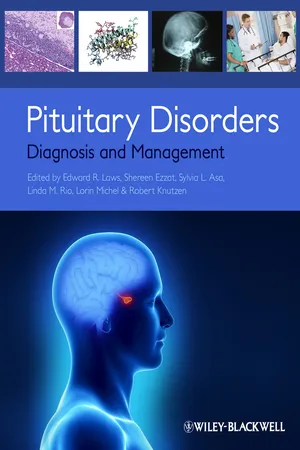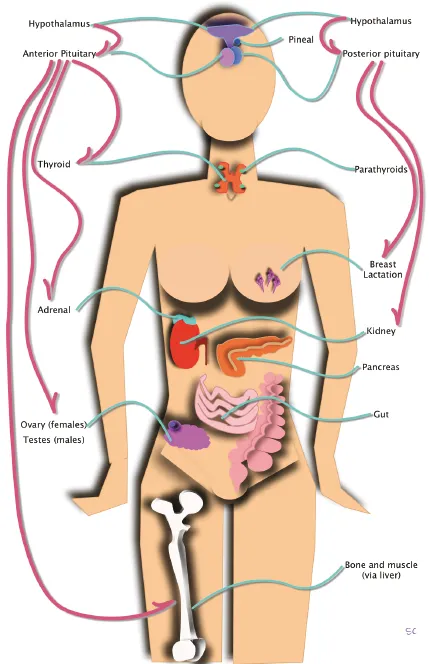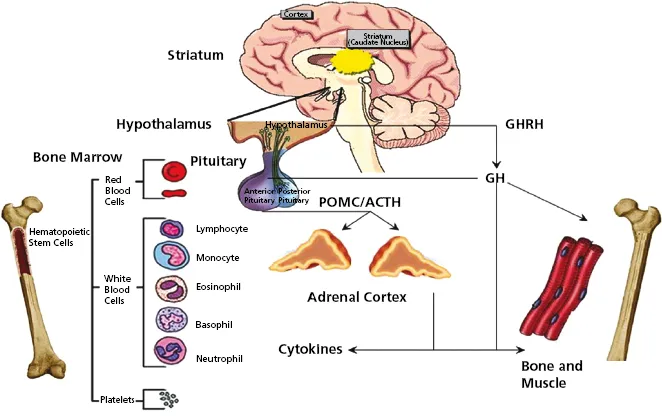Deficiency of endocrine function can be attributed to several types of pathological processes. Fortunately, most hormone deficiencies can be treated with hormone replacement regimens.
Isolated Hormonal Deficiencies or Resistance
These are usually caused by genetic mutations that interrupt the production of hormones, their receptors, or the enzymes required for their actions. The most common isolated hormone deficiency is congenital hypothyroidism [4], which can result in dyshormonogenetic goiter and cretinism, but in many countries complications are prevented by screening programs of neonates that lead to thyroid hormone replacement. Congenital adrenal hyperplasia is a spectrum of disorders due to a defect in one of the five enzymatic steps involved in steroid synthesis [5]; 90–95% of cases are caused by deficiency of 21-hydroxylase, resulting in marked elevation of 17-hydroxyprogesterone and male hormone excess at the price of diminished glucocorticoid reserves.
Isolated pituitary hormone deficiency most commonly involves growth hormone [6]. Rare examples of thyroid hormone receptor [7]or glucocorticoid receptor resistance [8] result in similar clinical manifestations as loss of hormone itself.
Tissue Destruction
Tissue destruction resulting in hormone deficiencies is another major cause of hormone deficiency. Tissue destruction can be the result of surgery, or may be caused by pressure or infiltration of the organ or cells by cancer or inflammation. There are many examples of each of these types of endocrine hypofunction. The most common iatrogenic hormone deficiency is hypoparathyroidism following thyroid surgery. In the pituitary, compression of normal tissue by cysts or tumors can result in hypopituitarism; tissue resection at the time of surgery can exacerbate hypopituitarism.
Inflammatory conditions can cause endocrine dysfunction, although acute and chronic infections rarely cause endocrine deficiencies in the Western world. In the sella turcica [9] this can happen in association with sphenoid sinus infection, cavernous sinus thrombosis, by spread of otitis media mastoiditis or peritonsillar abscess, or rarely by vascular seeding of distant or systemic infection by a wide variety of infectious agents, including fungi, mycobacteria, bacteria, and spirochetes. Other causes of secondary hypophysitis include sarcoidosis, vasculitides such as Takayasu’s disease and Wegener’s granulomatosis, Crohn’s disease, Whipple’s disease, ruptured Rathke’s cleft cyst, necrotizing adenoma, and meningitis. Complications of AIDS may also involve endocrine tissues, including the pituitary gland; involvement is usually infectious in nature (including Pneumocystis jirovecii, toxoplasmosis, and cytomegalovirus) and results in acute or chronic inflammation with necrosis.
Autoimmune endocrine disorders are a significant cause of hormone deficiency. Examples include type 1 diabetes mellitus due to autoimmune destruction of insulin-producing cells of the pancreatic islets and hypothyroidism due to the various forms of chronic lymphocytic thyroiditis including Hashimoto’s thyroiditis. Autoimmune inflammation has been described in almost every endocrine tissue. Most of the rare variants are associated with polyendocrine autoimmune syndromes that predispose individuals to immune destruction of endocrine and nonendocrine cells in multiple tissues, both endocrine and nonendocrine, the latter including melanocytes of the skin (resulting in vitiligo) and parietal cells of the stomach (resulting in pernicious anemia). The autoimmune polyendocrine syndrome type 1 (APS1) is the most well understood of these disorders, since its pathogenesis has been recently elucidated. This monogenic autoimmune syndrome is caused by mutations in the autoimmune regulator (AIRE) gene on chromosome 21 that encodes a nuclear protein involved in transcriptional processes and the regulation of self-antigen expression in thymus [10]. High-titer autoantibodies toward intracellular enzymes are a hallmark of APS1 and serve as diagnostic markers and predictors for disease manifestations.
In the pituitary, lymphocytic hypophysitis has been attributed to autoimmunity [9]. The disease is associated with other endocrine autoimmune phenomena and forms part of APS1; a tudor domain-containing protein 6 (TDRD6) was identified as the target of a putative autoantibody in APS1 patients and in patients with growth hormone (GH) deficiency, and is expressed in pituitary [11], but it remains to be proven if this is the causative antigen. The association of the classical form of lymphocytic hypophysitis with pregnancy may be attributed to hyperplasia of ...


